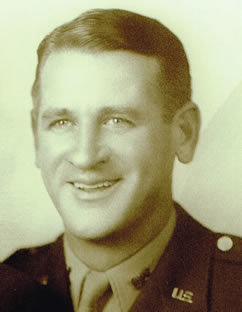Chief Warrant Officer 4
Anthony "Tony" Akromas
 Chief Warrant Officer Anthony ‘Tony’ Akromas was born on August 29, 1901, in Plymouth, Pennsylvania. He attended high school in Larksville, PA., but dropped out of high school shortly after World War I and enlisted in the Army to avoid a life in the Pennsylvania coal mines. He was trained as a machinist.
Chief Warrant Officer Anthony ‘Tony’ Akromas was born on August 29, 1901, in Plymouth, Pennsylvania. He attended high school in Larksville, PA., but dropped out of high school shortly after World War I and enlisted in the Army to avoid a life in the Pennsylvania coal mines. He was trained as a machinist.
Akromas served in the peacetime Army of the 1920s and 1930s at various installations, and in 1941 was appointed to Warrant Officer Junior Grade with the Military Occupational Specialty of 4515 Ordnance Warrant Officer while stationed in Hawaii. He survived the Japanese attack on Pearl Harbor while stationed at Schofield Barracks in Hawaii. During World War II, his evaluations described him as a ‘jack of all trades’, working on a variety of duties including ordnance, transportation, storage, and many other areas of logistics in the South Pacific during WWII.
After World War II, Akromas was assigned to the Coast Artillery School located at Ft. Winfield Scott, CA, and was put in charge of the harbor defenses. In this position he was responsible for installing the gun emplacements, radar stations, and mine stations. He conducted periodic inspections of organic armament materials, ammunition, spare parts, and unit supply procedures.
Assigned to Fort Lewis, Washington in 1951, Akromas deployed to the Korea with the 23rd Infantry Regiment, 2nd Infantry Division. During this period, he was assigned to a Combat Service Support Company with the 23rd Infantry Regiment and was responsible for the layout and arrangement of Regimental Ammunition Supply Points (ASP), where he supervised the receipt, classification, storage, and issue of ammunition. He also directed the recovery, collection, inspection, and segregation of damaged, abandoned, and captured ammunition. Considered an expert in these operations, Akromas’ technical advice was often sought after concerning the use of allied and enemy munitions and weapons. He received two Bronze Stars in Korea. As stated in one of the citations; “CWO Akromas served as the Munitions Officer for the 23th INF REG in the Naktong River area with tremendous enemy activity laced with inadequate roads and adverse conditions under enemy fire where he maintained a calm and confident posture, while distributing the ammo to the troops in an outstanding manner.”
Following the Korean War, he was stationed at Ft. Leavenworth where he served as the Bomb Disposal Officer for the 5th Army, which included all the EOD units west of the Mississippi River. During this assignment, he assisted in establishing a Mine Warfare Course to better educate Ordnance personnel assigned to his units of responsibility. Additionally, he was sent to top secret locations in Nevada as an advance observer for the testing of nuclear weapons. At the conclusion of the nuclear testing, he was sent to Aberdeen Proving Ground, MD to assist in developing the after action reports.
His final assignment was with the 571st Ordnance Ammunition Depot in Captieux, France. Once again he served as Bomb Disposal Officer, where he planned holistic management of all ammunition and explosives shipped into the European Theater received at the depot. Akromas retired from the Army in December 1954 and immediately went to work for the Defense Department as an Equipment Specialist. Relying on his training and familiarity with nuclear components, he worked at Raritan Army Arsenal from 1955-1962 and transferred to Picatinny Army Arsenal, N.J. and worked there from 1962 until 1971. In all of his evaluations his superiors always commented on the skills and knowledge he possessed; he was always the go-to person in any process involving nuclear weapons. Chief Warrant Officer Four Anthony ‘Tony’ Akromas died on February 4, 2009.